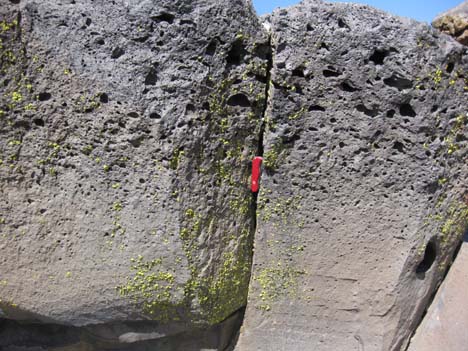9 April 2010
Hol(e)y basalt, Batman!
Posted by Callan Bentley
Today, our theme is vesicles. Here are some images of vesicles in basaltic lava flows in the Owens Valley of California, the same spot where we saw the baked fanglomerate that I showcased a few days back.
In this photo (and the zoomed-in detail shot below), you can see a couple of things. One is the size difference of the vesicles as you go up in the flow. Bigger bubbles represent larger loci of low density, and hence will be more likely to rise in a fluid batch of lava. This is the inverse of the phenomenon that causes graded bedding (heaviest grains sinking first). The result is a “graded vesicular lava flow.”
Also visible are several cooling joints that intersect to form columns. At the lower part of these columns, you can see arrest lines perpendicular to the column. Each of these subhorizontal lines represents a single instance of fracture propagation as the column separated from the rest of the flow. In composite, they form a “crack panel” like others showcased here in the past.
Let’s take a closer look at these distinctive features:
…And here’s some big vesicles, big enough to host a Swiss Army knife for scale:
They aren’t as big as some I’ve shown here in the past, but they were the largest vesicles I saw on the Owens Valley Field Forum last September. One thing I find interesting about this batch of vesicles is how they deform one another. The big one in the upper right has several smaller ones above it that “wrap around” its left edge. I envision this as the small bubbles hanging out with ~neutral buoyancy (ascendancy power), when up from below comes this massive bubble. As it pushes up (with its greater buoyancy), they smear out to the side, out of the way.
Likewise with the pair of large vesicles at lower right: it looks like the big flat one was there first, with the smaller “egg-shaped” one rising up from below and impinging on its larger upstairs neighbor. If the lava has been less viscous, the two may have merged into one, as blobs in lava lamps may be seen to do: a minimizing of surface tension, a lowering of the surface-area-to-volume ratio. Why would the smaller impinge on the larger? As I’m envisioning it, there would be a viscosity gradient in the cooling flow, with cooler temperatures towards the top (and hence higher resistance to flow). Deeper in the lava, temperatures would remain warmer, and hence the lava would be less viscous. I’m thinking that the big flat bubble had essentially risen as far as it could, but its top side was cooler than its more ductile bottom side, and so the bottom side was less resistant to the nosy intrusions of upstart bubbles from below.
Do you see anything else worth discussing in these photos?





 Callan Bentley is Associate Professor of Geology at Piedmont Virginia Community College in Charlottesville, Virginia. He is a Fellow of the Geological Society of America. For his work on this blog, the National Association of Geoscience Teachers recognized him with the James Shea Award. He has also won the Outstanding Faculty Award from the State Council on Higher Education in Virginia, and the Biggs Award for Excellence in Geoscience Teaching from the Geoscience Education Division of the Geological Society of America. In previous years, Callan served as a contributing editor at EARTH magazine, President of the Geological Society of Washington and President the Geo2YC division of NAGT.
Callan Bentley is Associate Professor of Geology at Piedmont Virginia Community College in Charlottesville, Virginia. He is a Fellow of the Geological Society of America. For his work on this blog, the National Association of Geoscience Teachers recognized him with the James Shea Award. He has also won the Outstanding Faculty Award from the State Council on Higher Education in Virginia, and the Biggs Award for Excellence in Geoscience Teaching from the Geoscience Education Division of the Geological Society of America. In previous years, Callan served as a contributing editor at EARTH magazine, President of the Geological Society of Washington and President the Geo2YC division of NAGT.
Get a piece of that last vesicular rock to use for storage of miscellaneous small items on your desk! Knives, hand lenses…
If only I had room on my desk for another rock, or even another stack of paper…
just an observation *_*
I notice in the first two pictures that the rock’s color gets gradually darker from bottom to top.
It’s a good observation… not sure I can offer any insightful interpretations, though. Anyone else want to explain the color change?
[…] entabulature in a basalt flow, or contact metamorphism along the bottom side of the flow, or the accumulation of vesicles towards the top of the flow. Say we find some of these “right-side-up” indicators in our blue layer, and it […]